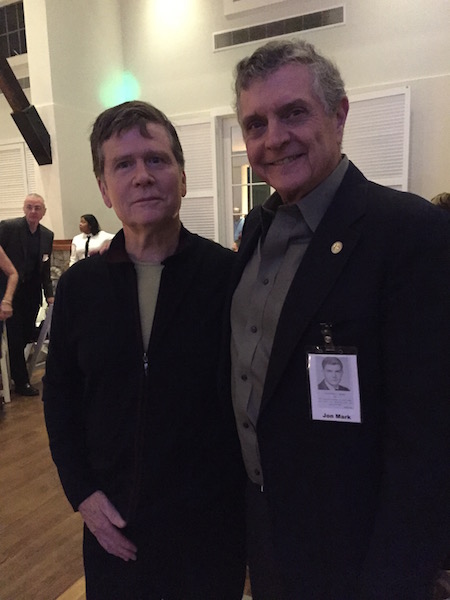Mayor Says the Village is in Great Shape and Urges Residents to Volunteer
- Details
- Written by Joanne Wallenstein
- Hits: 4136
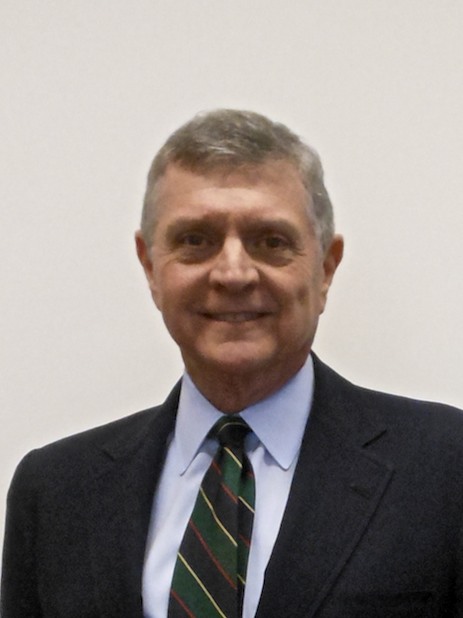 Scarsdale Mayor Jonathan Mark gave this report at the Scarsdale Forum Meeting on Thursday October 15. Here is the "State of the Village."
Scarsdale Mayor Jonathan Mark gave this report at the Scarsdale Forum Meeting on Thursday October 15. Here is the "State of the Village."
President Nadel and members of the Scarsdale Forum, thank you for having me here this evening.
The Village is in great shape.
Our new Village Manager, Steve Pappalardo, has stepped up from his deputy position and has taken firm control of day-to-day Village operations. He is ably assisted by our new Deputy Village Manager, Rob Cole and our senior professional department heads and staff.
Services are being delivered pursuant to a 2015-2016 budget that stayed within the state mandated so-called tax "cap."
Approximately 2.1 miles of our roads that were in the worst shape have been repaved.
Recently, the Scarsdale Police Department submitted to an exhaustive inspection and audit by two assessors from the Commission on Law Enforcement Accreditation (CALEA) in a bid to maintain its national accreditation status. SPD was initially awarded national accreditation by CALEA in 1989 and has since been through six successful reassessments, the last in March of 2011.
This year the department pursued a "Gold Standard Accreditation" requiring an even more critical examination of the department, operations and policies, including many more personal contacts and interviews with staff. The department was awarded the Gold Standard Accreditation in December 2014 and during the customary exit interview, both assessors stated they were extremely impressed with our agency as a whole.
Our fire department continues to provide exemplary service when called upon having recently maintained a national Insurance Service Office (ISO) risk rating of second from the top level that favorably impacts the cost of homeowner insurance for our residents.
In the last year, a major renovation of our principal water pumping station – Reeves Newsom – was completed. This followed the 2011 renovation of our Ardsley Road pumping station. These important capital projects, funded at just under $9 million, should, with proper maintenance, provide sufficient water pumping and pressure capability to the Village for the next 40 to 50 years.
The Recreation Department continues to deliver widely accepted programs, while modifying or adding new programs based on community demand. In addition, enrollment at the summer day camp program increased year-to-year with overall program revenues improving year-to-year as well. Currently 68% of the 2015-2016 fiscal year departmental expenditures are funded through operating revenues. This is the highest percentage in recent history achieved in accordance with a Village Board policy directive to reduce the burden on the General Fund property tax.
At the same time, the Village continues to face significant challenges.
First and foremost, is the overarching question of whether or not we can keep it up – or more precisely what are we willing to pay as a community to keep it up.
The budget process drives municipal operations. Since the 2008-2009 fiscal year Village budgets have risen on average 3.75% per year. Some of the costs covered by the budget are within the control of the Village. These include wages, debt service and capital expenditures. Other costs are not within Village control. Most significant of these are the cost of the Village's contribution to the New York State retirement systems: the New York State and Local Employees' Retirement System ("ERS") and the New York State and Local Police and Fire Retirement Systems ("PFRS"). In the six fiscal years 2010-2011 to 2015-2016, this line item has increased 107% from approximately $2 million to $4.4 million. This percentage increase takes into account a $500,000 year-to-year decrease in this line item for 2015-2016.
The contribution cost of ERS represents more than 19% of the payroll for Village general government employees and almost 25% of the payroll cost of police and fire department payroll. The slight decrease in this cost in 2015-2016 may be an indication that the trend of the preceding six years may be slowing. The point for this discussion is, however, that even though the costs of these systems are not within the control of the Village, they are weighed in the balance when budgeting for costs that are within Village control and so play a role in determining the level of services to be provided.
One other technical point worth noting with respect to the costs of participation in these New York State retirement systems for those of you that closely follow Village finances. The Government Accounting Standards Board establishes accounting and financial reporting standards for governments. In June 2012, GASB issued Statement No. 68 that established new accounting and financial reporting requirements for municipalities and school districts that provide their employees with pensions. In general, Statement No. 68 requires that municipal financial statements report a net pension liability, pension expense and pension related deferred inflows and outflows of resources based on their proportionate share of the collective amounts for all municipalities and school district in the relevant plan. The Village financial statements, available on the Village web site under the Village Treasurer tab, reflect the reporting required by Statement No. 68. Because one of the requirements of Statement No. 68 is to report net pension liability as debt, it may be that during future periods in which this liability increases, total Village liabilities reported as required may exceed total Village assets and create the appearance of the Village being bankrupt. However, since the net pension liability is a non-cash accrual based on actuarial data, it does not reflect the year-to-year actual cash cost of the Village contribution to these systems and so will not reflect the ability of the Village to pay its debts when due. It is also important to note that the State of New York, not the Village, is responsible for providing the pension benefit to eligible Village of Scarsdale retirees. Mention is made of this technical accounting point so that those who closely follow Village finances and budget are not unnecessarily alarmed by this accounting change.
Interestingly, the rating agency Moody's that rates the Village debt has already taken this accounting change into account. In a March 2015 press release, Moody's stated "Moody's rating methodologies already consider unfunded pension liabilities as debt-like obligations. Thus, the new accounting has little credit impact because Moody's already approaches the liabilities in a similar way."
As noted, this year's budget stayed within the so-called tax "cap." In terms of expectations, we should not expect that next year's budget will stay within the "cap" if services are to be maintained at present levels. It is expected that the tax "cap" established by the NYS Comptroller for the upcoming fiscal year will be less than one percent. Each year the Board and Village Staff look at each departmental budget and cost center, to assess whether the services provided, and the costs of doing so, are reasonable in light of resident expectations. The process this year will be no different from prior years in that regard. It may be that after going through such analysis the tax "cap" might be met, but with such a low ceiling, that may be an unrealistic expectation, especially with the capital infrastructure responsibilities facing the Village which will be discussed in some detail later. In addition, other factors, including any portion of a year-to-year increase in the NYS pension contribution in excess of 2% which is exempt from the "cap" and a NYS identified assessment growth factor which is added to the tax "cap" limit, further impact the allowable levy increase. Therefore, even if the budget stayed within the "cap," a budget increase year-to-year may in fact exceed the "cap" percentage.
Future capital projects identified in the Capital Budget to be bonded include a long-pending multi-jurisdictional project for flood improvements along the Hutchinson River, a structural improvement and space renovation of Fire Station #1 and work to rehabilitate the Freightway Garage, although there are no plans for this last matter at present. The issuance of $3.5 million in bonds for the Fire Station project was approved by a prior Board and the bonds were issued in January 2014 at an interest rate of 3.48%, although the work has yet to commence due to the necessity to revise the original plans based on budgetary concerns noted during final construction plan preparation. The Board should be reviewing the revised drawings this fall in preparation for public bidding for the construction contract. Funding for the other projects mentioned has not been approved and in the case of the Hutchinson River Project will not go ahead unless Westchester County, which has verbally committed to funding 50% of project costs, the City New Rochelle and the Town of Eastchester contribute funds to this project.
Other matters:
Capital Projects
As noted, approximately 2.1 miles of the roads  identified as being in the poorest condition have been repaved. Unfortunately, with repaving contractors in very high demand, they can dictate when and where they work—within the parameters of what is contracted for. At present, there is a pause in the repaving work as the contractor has moved on to another municipality. The staff is doing its best to have more work done before winter sets in, however if not, additional roads will be paved in spring 2016. By the end of this project approximately 4 miles of roads will have been repaved.
identified as being in the poorest condition have been repaved. Unfortunately, with repaving contractors in very high demand, they can dictate when and where they work—within the parameters of what is contracted for. At present, there is a pause in the repaving work as the contractor has moved on to another municipality. The staff is doing its best to have more work done before winter sets in, however if not, additional roads will be paved in spring 2016. By the end of this project approximately 4 miles of roads will have been repaved.
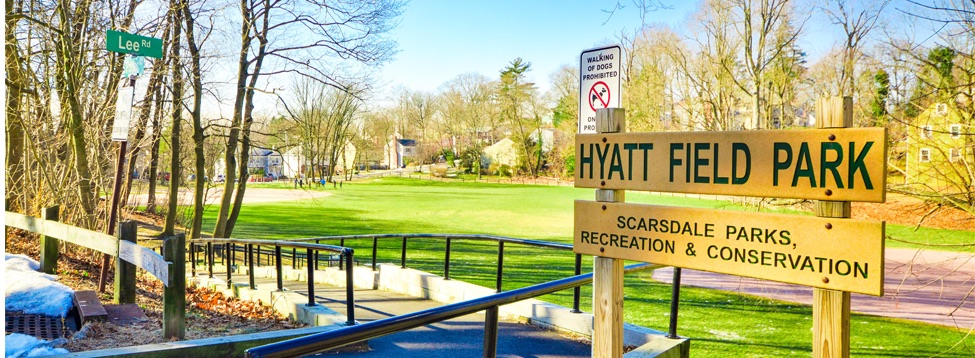 There are a number of other on-going capital projects and some others anticipated. The installation at Hyatt Field Park of new playground equipment, basketball court and a comfort station is underway. Weather permitting, it is hoped that the new equipment and associated improvements will be in place by mid-November. The Recreation Department led by Jason Marra worked diligently on the planning for this project, and engaged in a very useful dialog with residents adjacent to Hyatt Field as part of the process.
There are a number of other on-going capital projects and some others anticipated. The installation at Hyatt Field Park of new playground equipment, basketball court and a comfort station is underway. Weather permitting, it is hoped that the new equipment and associated improvements will be in place by mid-November. The Recreation Department led by Jason Marra worked diligently on the planning for this project, and engaged in a very useful dialog with residents adjacent to Hyatt Field as part of the process.
Work on the replacement staircase on the northbound side of the Metro North station platform is beginning. Although this is a Village staircase to build, because the staircase connects to the Metro North platform, certain approvals from Metro North were required. These approvals were obtained last week and the construction work commenced on Tuesday, October 13th. If the weather and Metro North continue to cooperate, we hope to have the replacement staircase in place before winter sets in.
Future work on sewers anticipated
During the past several Board meetings, status reports have been given with respect to ongoing conversations with the Westchester County regarding an intermunicipal agreement (IMA) arising from the County's need to comply with certain NYS Department of Environmental Conservation consent decrees governing the County's sewerage discharge into Long Island Sound. Municipalities are engaged in this discussion because their municipal sewerage collection systems empty into the County's system. It is expected that a study of the sewer system will be a requirement of the IMA to identify areas of stormwater inflow and infiltration ("I&I") entering the sewerage system, resulting in flows exceeding the 150 gallons per capita per day limit established by the County in their Sewer Act. These excessive flows that occur during certain rain events, contribute to the overtaxing of the County-owned sewerage treatment plants resulting in untreated sewerage or sewerage with excessive nitrogen levels from the stormwater, being discharged into the Sound. Depending on what the study shows, some remediation work will be required. The cost of this work will, of course be borne by residents, but the mechanism for funding the work is to be determined. Funding could be provided by the Village from a combination of real property taxes, sewer rent and grants (application for which has already been made). Alternatively, funding could be provided from through the County's Sewer District Tax that municipalities collect from residents and remit to the County. Whether the allocation of cost by one mechanism or the other is preferable is a matter of debate, although it would appear that allocating the cost of this project across the entire sewer district might be a fair approach with some cost savings being available due to economies of scale and a larger paying base as property owners exempt from paying property taxes, are subject to paying sewer district taxes. However, as noted, whatever the mechanism used, residents will bear the cost of the work once it is contracted for.
LED Street Lights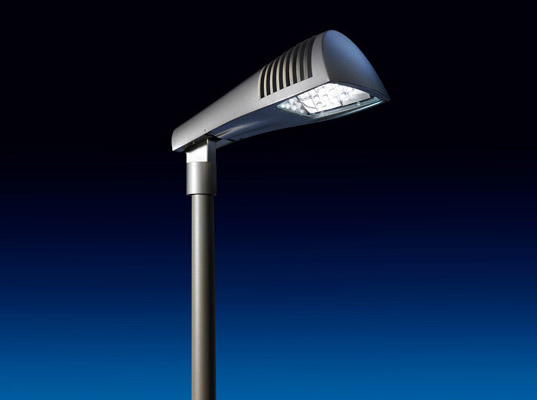
The Board appointed an Ad Hoc Committee to study the subject of changing Village high pressure sodium mercury vapor street lights to LED lights. The Ad Hoc Committee, comprised of Village residents and members of Village staff, has made very good progress on this issue. Working with the Department of Public Works, approximately 11 test lights have been installed with 15 more test lights to follow. The installations are in different parts of the Village so the lights can be observed in a variety of conditions and settings.
The test LED lights have different qualities and the Committee has set up a web-based system by which residents can comment on the test lights. Signs are placed on the street poles where the demonstration LED lights are installed so that an interested resident can comment on the qualities of a particular light by referencing a comment to the location information provided on the street pole sign. The Ad Hoc Committee has established a web site to which comments may be posted.
Given the potential for LED lights to transform the appearance of the Village at night, obtaining significant resident input during the demonstration period will be very important and useful in identifying the next steps in the process. I urge residents to avail themselves of this opportunity. Note that this initial demonstration will be the first of two or more demonstrations of the LED lights being considered. No final decision is to be made on which LED lights are to be selected until the Board and the Village staff have collected sufficient information and community feedback to make an informed judgment on how to proceed.
Our thanks go to the Ad Hoc Committee, particularly its Chair Victor Goldberg, and the DPW for their diligent and thoughtful work on this project to date.
Update on revaluation
2013/2014 revaluation grievance statistics (as of July 30, 2015):
For 2014: There were a total of 950 grievances filed.
At the Board of Assessment Review level, 163 matters resulted in reductions.
731 matters were appealed as follows:
585 matters were appealed in Small Claims Assessment Review, or SCAR, proceedings;
146 were appealed in tax certiorari proceedings.
Of the 585 SCAR proceedings, 469 were settled, 30 went to trial of which 19 resulted in reductions and 11 resulted in no reduction. 86 SCAR proceedings were withdrawn or discontinued.
Of the 146 CERT filings, 1 was settled and 145 are pending.
The dollar amount of reductions was approximately $37.6 million by the BAR; $116 million by SCAR proceedings and $362,000 in the one settled CERT matter. The total was approximately $154 million of reductions. While this is a big number, when compared to the total assessed value of Village property of $9.1 billion, it represents a less than 1.7% change. It is noted that with 145 CERT proceedings still pending, this number will likely change further though it may be an extended period of time before those matters are resolved.
For 2015: There were 361 grievances filed.
At the Board of Assessment Review level, 56 matters resulted in reductions.
199 matters were appealed as follows:
134 matters were appealed in SCAR proceedings.
65 matters were appealed in CERT proceedings.
Since the filing deadline for appeals is today, the number of SCAR and CERT matters may increase if additional appeals postmarked today are received. All 2015 appealed matters are still pending.
Status of 2016 Reval
The 2016 revaluation process is proceeding on schedule. A review of 2013-2015 sales and inventory data has been completed. Sales verification data will continue on a bi-monthly basis up until 2016 valuations are set. Field review of assessments will begin in November and run through February 2016. Reconciliations and adjustments will be made to models and values as necessary. The Village Board has scheduled a Committee of the Whole public meeting for November 17, 2015 at 6:30 pm to get an update on where this process stands.
Water
The Water Department through its operating Enterprise Fund purchases our water from New York City's system. The City has increased the rate for water purchases from time to time over the past several years and the Village had spread out increases that pass along these rising costs over somewhat longer intervals. While there was no increase in the Village water rate last year, the Board will most likely implement an increase for the next fiscal year to pass on costs that continue to rise and to start building an adequate fund balance to cover, in part, anticipated future expenditures for the water system infrastructure. It is presently projected that over the next 15 years an estimated $15 million may be needed to fund improvements to the supply and distribution systems, including the cement lining of the 100 year old distribution pipes and replacement of the equally aged water valves. The Village is currently participating in a New York City Water Board Demand Management Study of Scarsdale's water system. Although the final report has yet to be issued, the Water Board is committed to funding up to $650,000 in system improvements and the institution of Village-wide conservation efforts.
Separate from the Village water department operations, Water District #1, of which Scarsdale is a part, is required, pursuant to Federal and State regulations, to provide ultra violet treatment of the water to kill certain pathogens. To this end, Water District #1 is currently building two ultra violet treatment plants in White Plains on the 48 inch pipe from the Kensico Reservoir serving the Village. The estimated cost of the two plants is $10 million and the anticipated service operation date sometime in 2018. In the future, if full filtration of the water supply system is required, a treatment plant on New York City Water Board property in Valhalla would be built replacing the aforementioned ultra violet plants. If this project, currently estimated at $100 million, moves forward, it would be funded by the County Water District Tax which is allocated among Scarsdale, White Plains, Mount Vernon and Yonkers residents and will not be part of the Scarsdale water or tax bills.
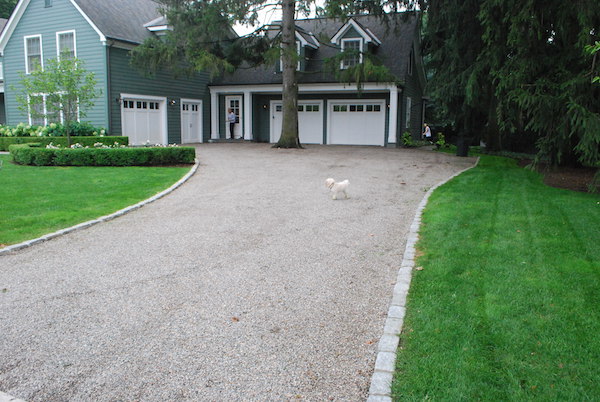 Gravel and impervious surfaces: For a number of months there had been pending a proposed change in the Village Code that would have treated gravel as an impervious surface for purposes of determining lot coverage. A moratorium on the treatment of gravel as pervious was in place during the pendency of the proposal. After considering this matter over many months, the Board determined at its meeting last Tuesday night to not make the proposed change in the Code. At the same meeting the moratorium was terminated. While each Board member had slightly different rationales for not adopting the proposal, a common theme running through all Board member comments was that the proposal did not squarely address the development concern most commonly expressed. That is, in the view of some, houses too large for certain sized lots are proliferating to the point where the character of some neighborhoods or streets are being changed and not for the better. Having voted down the proposal, there remains the perennial question of whether more should be done to manage development in the Village. In my view, which I and other Board members expressed at the Tuesday night meeting, this topic deserves further consideration. It is hoped that the panel discussion following this talk tonight might provide additional insights on what direction we might next take on this important subject.
Gravel and impervious surfaces: For a number of months there had been pending a proposed change in the Village Code that would have treated gravel as an impervious surface for purposes of determining lot coverage. A moratorium on the treatment of gravel as pervious was in place during the pendency of the proposal. After considering this matter over many months, the Board determined at its meeting last Tuesday night to not make the proposed change in the Code. At the same meeting the moratorium was terminated. While each Board member had slightly different rationales for not adopting the proposal, a common theme running through all Board member comments was that the proposal did not squarely address the development concern most commonly expressed. That is, in the view of some, houses too large for certain sized lots are proliferating to the point where the character of some neighborhoods or streets are being changed and not for the better. Having voted down the proposal, there remains the perennial question of whether more should be done to manage development in the Village. In my view, which I and other Board members expressed at the Tuesday night meeting, this topic deserves further consideration. It is hoped that the panel discussion following this talk tonight might provide additional insights on what direction we might next take on this important subject.
The Village is successfully dealing with the many challenges that confront it in delivering municipal services to residents. However, running a municipal government is an organic process that requires flexibility and innovation to meet both planned and unplanned changes. It also benefits from resident input. Too often the Village Board and staff find themselves having to make decisions with minimal, or even no, resident input. There are many opportunities for residents to have an impact in how our Village operates from serving on the various boards and councils to the Board of Trustees to appearing at the public sessions of the twice monthly Village Board meetings. Volunteerism in the Village seems to be at a low ebb for reasons that are not clear to me even when taking into account the busy lives our residents lead. It is hoped that the group assembled here this evening can convince some more of our neighbors to find time in their schedules to join in our collective effort to continue to make Scarsdale the Village in the Park we all cherish
Thank you very much for your attention.
Trustees Overturn Gravel Moratorium and Reject Gravel Amendment
- Details
- Written by Joanne Wallenstein
- Hits: 7161
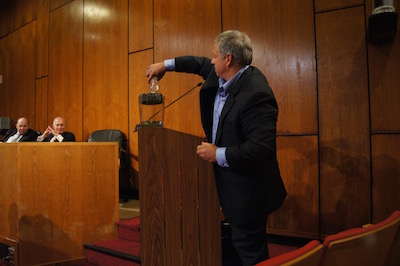 Though opponents of a proposed law to limit lot coverage were prepared for an argument at Village Hall on Tuesday night October 13, rather than continuing the debate, they ended up congratulating the trustees and each other after they learned that the Board had decided unanimously to vote no to the change.
Though opponents of a proposed law to limit lot coverage were prepared for an argument at Village Hall on Tuesday night October 13, rather than continuing the debate, they ended up congratulating the trustees and each other after they learned that the Board had decided unanimously to vote no to the change.
The Scarsdale Village Board had passed a moratorium on the use of gravel to meet lot coverage restrictions in February 2015. The moratorium was enacted to give the Board time to study the issue and hold hearings.
Builders, realtors and owners of large properties objected to the law because it would prevent them from counting gravel as a pervious surface – like grass – and therefore limit their ability to install impervious surfaces such as pools, tennis courts, patios and long driveways that count in the lot coverage calculation.
After many lengthy hearings, all six voting members of the Board decided to vote against the provision – primarily because they saw it as a roundabout method of limiting home sizes.
Trustee Callaghan looked back at Scarsdale history and noted the importance of weighing property owners' rights against the communities need for open space. He recalled an application from Fox Meadow Estates, Inc. to build a 280-unit apartment building in Butler Woods in Fox Meadow.
Trustee Stern said that the amendment was proposed after the board received "many complaints of large houses with small setbacks on small lots." He said, "The moratorium was in response to village stakeholders who were being outgunned in their own neighborhoods. But as this went along, there was a huge outcry from other stakeholders and people who wanted to build structures on their properties."
However he said, "I would like to find another way to limit house size."
Referring to the gravel, Trustee Deb Pekarek said, "There are two conflicting standards in village code. We are here to consider if gravel should be considered impervious. In 33 municipalities surveyed, all but one consider gravel impervious.
But, does this code change do what we hoped it would do? If implemented will it reduce the appearance of bulk? It does little to reduce the appearance of bulk.
Even the consultant thought that the gravel change will not impact home size."
She continued, "While I believe a FAR study would be costly I hope we continue the conversation in the next few months."
Marc Samwick told the audience that their "input has been valuable and that zoning changes are some of the most important issues that come before the board." He called for a "wider assessment of zoning," and for the board to "address overbuilding by addressing zoning – FAR, maximum height, and maximum setbacks." About the proposal, he said, "there are too many unintended consequences. I cannot support it and will vote to appeal the moratorium."
Carl Finger offered some observations on the process. He said, "I appreciate the feedback we have received and the work of our consultant and our Village Planner Liz Marrinan. Sometimes the tenor of comments directed at them was not appropriate."
He continued ... "There is little doubt that expansion and overbuilding of lots must be faced if we are to maintain the community aesthetic. The combination of teardowns and expansions infringe on the streetscape, land, open space, and light."
He then referred to a passage of a letter from Melinda Witmer that was read by Dawn Knief at the previous hearing. The letter equates the proposal to racism and says, "I will point out that those same "maintain character" words are the kinds used in many instances – including the pre-Civil Rights South – to try to prevent change to communities in order for a small and opinionated few to tyrannize others. These are the words used to maintain segregation and keep people of color and women from sharing buses and golf courses. Our neighborhoods are in constant change."
Finger said, "Equating this to racism was disturbing. It does a disservice to those involved and it demeans all of us and anyone who has suffered from racism."
He continued, "The premise that the board predetermined their decision was unfounded. The board proceeded in an open and deliberate manner. The claim that there were not enough hearings was unreasonable."
"I did not appreciate the inappropriate displays of showmanship and lack of respect which I hope will not be repeated. I was also unmoved by threats of lawsuits, loss of developers and the reduction of property values. These are the same arguments used in all land use discussions. The idea that the "sky is falling" has never held water when put to the test."
Finger opted to vote against the proposal because he said, "Overbuilding on small lots must be addressed but I don't think it will grant sufficient relief."
The Mayor spoke last, and he too expressed concerns about over development, saying that if market forces and the rights of property owners are the sole determinants, "new construction presses to the limits of what the building code allows." However he believes that redefining gravel would do little to address the issue. He did say that it would be "worthwhile to continue the discussion of this issue (open space and community values) to determine whether or not there is community interest in making some other sorts of refinements to the Code. "
His comments in their entirety are published below.
The trustees then voted against the code change and to appeal the moratorium. An attorney, a resident and several developers commented and thanked the Board for listening. Though the builders previously claimed that the Board was not listening, after the vote went their way, their tenor changed and they lauded the board and each other.
Builder Steve Rakoff, who had vehemently opposed the proposal said, "I am proud of this inclusive process. Hopefully we can continue this process. Realtors and builders are a great asset! It is so important that we can get together and get this right."
David Fenton of Aspen Road, who runs Twin Oaks Construction said, "I look at the audience and the builders and what is being built. We have fantastic builders here
Ron, Steve Rakoff, Lee Handler, ...these are great builders. The homes that all of us have done are some of the nicest homes that have been built in a long time. We put our heart and soul into it. We are very involved in the decisions that take place and put social responsibility into the product."
One lone speaker took the mike to ask the Trustees to continue to address the issue of overbuilding in Scarsdale. Cay DeSa of Lawrence Road in Heathcote said, "I live around the Heathcote School. All the English cottages are being replaced by large houses on small lots. We are beginning to see more in the pipeline. The problem is the big house on the small lot. I am asking you to please continue looking into the heart of the issue. It's distressful to walk down the street and see houses that just don't fit. They are blocking out light and blocking out air. Please maintain the village in a park."
Here are Mayor Jon Mark's comments in their entirety:
I have been persuaded that the proposal to change the definition of gravel in the Village Code should not be adopted. The principal factor that leads me to this conclusion is that the proposal does not really address the issue that seems to be at the core of most discussions of the topic of managing development in the Village. That core issue which we as Board members hear most frequently is whether our current building code permits the construction of homes with a size, height and bulk that is out of character with the neighborhoods in which they are situated.
Without addressing that issue at this moment, it now seems clear to me both in terms of what has been said and presented to this Board, as well as a recent drive around the Village, that the proposed change in the definition of impervious surfaces would not address this issue – it was not intended to. Rather it appears that much of the impact of the proposal, if adopted, would fall on larger properties in the Village and would inhibit the building of accessory structures such as pools and tennis courts. It might also impact smaller properties eliminating some flexibility in the event an owner wished to add a room to an existing home. The proposal does not, nor was intended to, address the issue of the size, height and bulk of homes – although as an additional factor considered in designing a home it might have that effect as well. However, a drive around the Village reveals that where a home might seem to appear oversized as compared to its neighbors – and admittedly, this is a subjective judgment -- it is not because the house has a gravel driveway. To the contrary, such homes for the most part have asphalt driveways. Therefore, because the proposal does not address what I believe seems to be a core development issue for some, I intend to vote against adopting the proposal. Similarly, I intend to vote for the repeal of the present moratorium that treats gravel as impervious.
I do, however, want to take this opportunity to comment on the issue of managing development in the Village. One of the myriad issues that arise in the context of development is open space. The subject of open space can be on the table directly when an application triggers a requirement to assess a fee for parks, or indirectly as the result of applying Village code provisions that address lot coverage, building size and storm water management. Without a doubt, as the Village develops, perhaps a better term is evolves, and housing stock is rebuilt or remodeled, open space is sometimes lost. This sort of change is inevitable so long as the Village continues to attract new residents due to the quality of our schools and the superb environment we have worked hard to create and maintain as a place to live. To attempt to simply halt this evolutionary process is unrealistic and likely counterproductive. Housing stock must be renewed and revitalized. Change is constant.
That having been said, it also seems counterproductive 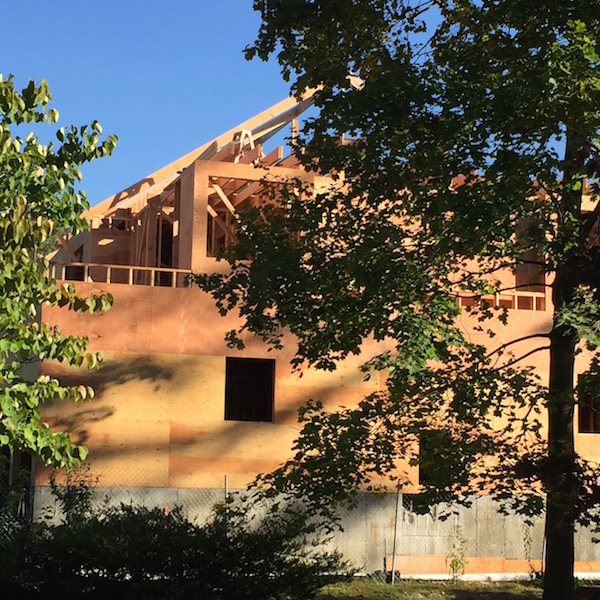 to the efforts presently made to maintain the desirable physical qualities of the Village to take a view that market forces and the property rights of individual land owners should be the sole determinants of how we manage our open spaces. Build it and they will come is a powerful mantra, but left unaddressed, pursuing it could easily lead to a Village in which houses are increasingly crowded together as new construction presses to the limits of what the building code allows. Some residents that we hear from feel that certain neighborhoods or streets have already reached that point.
to the efforts presently made to maintain the desirable physical qualities of the Village to take a view that market forces and the property rights of individual land owners should be the sole determinants of how we manage our open spaces. Build it and they will come is a powerful mantra, but left unaddressed, pursuing it could easily lead to a Village in which houses are increasingly crowded together as new construction presses to the limits of what the building code allows. Some residents that we hear from feel that certain neighborhoods or streets have already reached that point.
In fact, we do not leave the evolution of the Village unaddressed. Significant legitimate community concerns – and community values – are already embodied in our building code. Code provisions addressing set-backs, floor area ratio, or FAR, minimum frontage requirements, restrictions on the height of certain fences and retaining walls, our storm water management laws and regulating the decibel level permitted for emergency generators are a few of the numerous instances in which an individual's rights to develop a piece of property is managed and constrained to a significant degree in light of legitimate community interests.
Critics of the present proposal note that should it be adopted it would have a negative effect on property values. This sort of argument might be raised to any proposal that seeks to manage development in some fashion. To this point I note that there are myriad factors ranging from the property itself, to local matters to national and even international matters that affect property values. Any one change in our building code may or may not negatively affect property values but arguments that focus on one of many possible factors can be misleading and among other things, ignore this larger economic reality. Scarsdale does not exist in a bubble. However, Village building code provisions that reasonably address a legitimate community interest in open space, for example, are in our Code and are clearly supportable despite the fact that they may restrict the exercise of individual property rights.
Open space is what the present proposal was really about. As I mentioned, I am not in favor of adopting it. However, there remains a question as to what to do, if anything, going forward. We can leave the Code alone, turn our attention to other matters and simply allow development or evolution to proceed as is. Based on what is observable this may, over an extended period of time, lead to the filling in of our remaining open space with structures. Or we can take a further look at our Code and attempt to modify it in some other way to address directly the question noted. There will be critics of any changes that might be proposed and undoubtedly some of the criticisms will echo the criticisms we have heard to the proposal on the table today. But I believe we should make an effort. Some residents who have spoken in prior Board meetings or who have written us on this topic have also made that suggestion.
We all benefit and property values benefit from the spaciousness of our physical surroundings. Based on what this Board hears from some of our neighbors, that community value deserves some more attention. For these reasons, I believe it would be worthwhile to continue the discussion of this issue to determine whether or not there is community interest in making some other sorts of refinements to the Code. The answer may be difficult to arrive at and ultimately may depend on what we as a community want to leave to those who come after us.
You can watch the meeting in its entirety on the Scarsdale Cable Channel here.
Mayor Jon Mark Welcomes Home the SHS Class of 1965
- Details
- Written by Joanne Wallenstein
- Hits: 4281
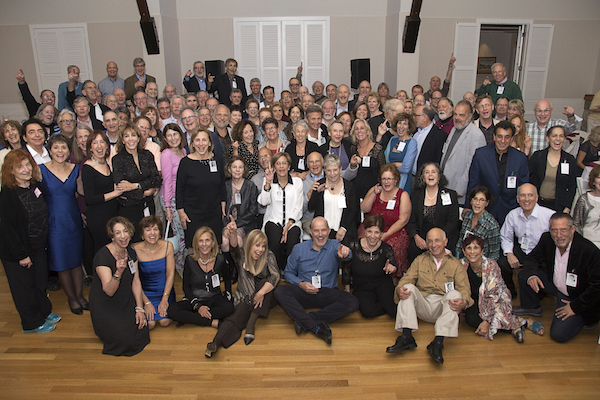 This weekend, Scarsdale Mayor Jon Mark welcomed back 190 of his classmates from the SHS Class of 1965. Here is a letter he wrote to the class on the occasion of the reunion:
This weekend, Scarsdale Mayor Jon Mark welcomed back 190 of his classmates from the SHS Class of 1965. Here is a letter he wrote to the class on the occasion of the reunion:
To the SHS Class of 1965: Welcome back. I am very much looking forward to seeing all of you this evening. My past 50 years have been filled with a variety of ups and downs probably not unlike what many of you have experienced. Of immediate note is the present "up" in which I find myself serving as Mayor of Scarsdale. To answer a question I am often asked, "no, this is not a position I ever aspired to or dreamed of holding." But here I am -- and I am glad to be serving the town I grew up in.
There is a room in Village Hall – the Trustees room – where the Board of Trustees, which I Chair as Mayor, meets twice a month. On the walls are photographic portraits of former Mayors. Among them are Jean Stone – the first woman Mayor and Greg Marx's aunt, George Szabad, Ellen Szabad's father, and Seymor (Chuck) Sims, Barbara Sims' father. There may be others who are relatives of some of our classmates but these are the names I recognize. I am humbled to be in such good company. (Mark later learned that Mayor Warren Cunningham was the great grandfather of his classmate Bob Shay and Mayor Malcom Pirnie was the grandfather of classmate Pam Pirnie.)
The Village has changed in a variety of ways since we grew up here. It is more built up, housing prices and real property taxes are high and the kids' sports leagues seem more competitive than recreational. However, in important ways the Village is the same as it was in 1965. Education and the schools remain the predominant reason families move here – and are most of the reason for the high real property taxes. The desire for beautiful park-like surroundings in which to raise a family is still an attraction to those who come here from, and commute to, New York City.
Serving as Mayor provides an opportunity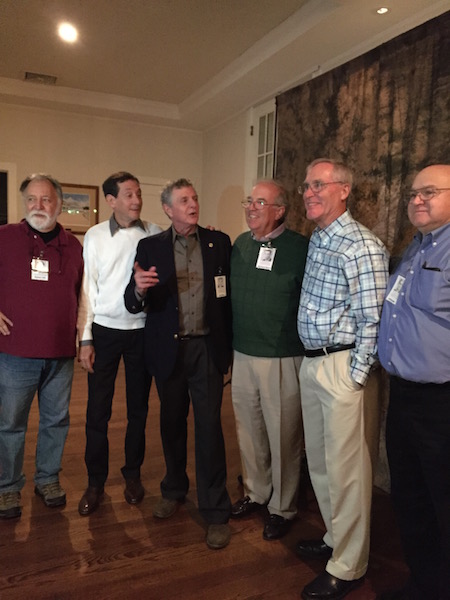
When we graduated from the High School in 1965, I was not thinking of coming back. My wife, BK, and I returned in January 1992 and I am glad we did. I look forward to seeing all of you coming to reunion today and tomorrow and hearing your stories as well.
Sincerely,
Jon Mark, Mayor
Who Deserves the Scarsdale Bowl?
- Details
- Written by Joanne Wallenstein
- Hits: 3739
 The 2016 Scarsdale Bowl Committee will begin its work in early December to select the 2016 recipient of the Scarsdale Bowl and is seeking recommendations from the community for a possible honoree. The Scarsdale Bowl, under the sponsorship of the Scarsdale Foundation, has been awarded annually since 1943 to an individual, or in rare instances, to a husband and wife, who has given "unselfishly of his/her time, energy and effort to the civic welfare of the community." The founding donors of the Bowl believed that "many who serve generously and voluntarily, without office, honor or publicity, are those deserving of having their names permanently inscribed on the Scarsdale Bowl."
The 2016 Scarsdale Bowl Committee will begin its work in early December to select the 2016 recipient of the Scarsdale Bowl and is seeking recommendations from the community for a possible honoree. The Scarsdale Bowl, under the sponsorship of the Scarsdale Foundation, has been awarded annually since 1943 to an individual, or in rare instances, to a husband and wife, who has given "unselfishly of his/her time, energy and effort to the civic welfare of the community." The founding donors of the Bowl believed that "many who serve generously and voluntarily, without office, honor or publicity, are those deserving of having their names permanently inscribed on the Scarsdale Bowl."
Michelle Lichtenberg is serving as chair of this year's Scarsdale Bowl Committee. The members of the committee serve staggered two-year terms. The newly appointed Class of 2017 includes Beth Ehrich Berkley, Jonathan Bradlow, Fran Galloway, Gary Katz, Janet Korins, Eli Mattiolli, and Jyoti Ruta. The continuing Class of 2016 includes Felicia Block, Kay Eisenman, Susan Hochvert, Anne Lyons, Michael Pollack, and Jay Musoff. Jane Veron, Scarsdale Foundation trustee, will serve on the committee as the liaison, and Robert Jeremiah is serving as secretary/treasurer. Evelyn Stock, president of the Scarsdale Foundation, is an ex-officio, non-voting member.
The Scarsdale Bowl will be awarded at a dinner on Wednesday, April 13, 2016, at The Fountainhead in New Rochelle. The ceremony will pay tribute to the 2016 honoree and to the spirit of volunteerism, central to the civic life of the Scarsdale community.
The Bowl Committee enthusiastically welcomes community input. It will hold its first meeting December 6, 2015, and requests that residents contact any member of the committee with suggestions of potential recipients. Recommendations are requested by November 10, 2015, although suggestions will be accepted at any time prior to the Committee's December meeting. Suggestions should be emailed to the Committee at: scarbowl@gmail.com. Questions may be directed to the Scarsdale Bowl Committee Chair, Michelle Lichtenberg, at (914) 725.6545.
Additional information about the Scarsdale Foundation and the Scarsdale Bowl can be found at www.scarsdalefoundation.org.
Village to Test LED Street Lights
- Details
- Written by Joanne Wallenstein
- Hits: 6018
 This letter was sent to Scarsdale10583 by Vic Goldberg, Chair, Ad Hoc Committee on LED Streetlights: On April 28, 2015, the Board of Trustees established an Ad Hoc Committee to research Light Emitting Diode (LED) street lights in order to improve lighting, reduce Village costs for electricity and maintenance, and conserve energy. To that end, the Committee was asked to develop a pilot program and make a recommendation on how best to move forward. As chair of the Committee, I am providing this update on the project, and request your assistance in obtaining community feedback as the Pilot Programs proceed.
This letter was sent to Scarsdale10583 by Vic Goldberg, Chair, Ad Hoc Committee on LED Streetlights: On April 28, 2015, the Board of Trustees established an Ad Hoc Committee to research Light Emitting Diode (LED) street lights in order to improve lighting, reduce Village costs for electricity and maintenance, and conserve energy. To that end, the Committee was asked to develop a pilot program and make a recommendation on how best to move forward. As chair of the Committee, I am providing this update on the project, and request your assistance in obtaining community feedback as the Pilot Programs proceed.
Since April, our Committee has conducted extensive research on LED street lighting, met with vendors, and examined LED streetlights installed in neighboring communities. Based on the above and given Scarsdale's largely residential setting, we believe it is important to test a variety of lights including some with warmer, less bright colors than have been installed elsewhere. We plan to launch a two-stage pilot program on select Scarsdale streets.
Stage One Mini-Pilot - Planned for September-October, 2015 Twenty five LED streetlights of varying light colors and brightness will be installed on sections of Heathcote Road, Fox Meadow Road and Madison Road. Signage will be affixed to each of the LED poles identifying the pole number and a website for residents to provide feedback and/or ask questions. Residents will also have a more extensive opportunity to provide feedback during the Full Pilot period.
Stage Two Full Pilot - Planned to begin late November or early December Based on what we learn from the Mini-Pilot, the Full Pilot of 100 plus LED streetlights will run for about three months. Although there will not be a Full Pilot LED pole location in every neighborhood association area, locations will be dispersed throughout the Village and will represent the full array of types of streets. Again, signage will be affixed to each of the 100 plus LED streetlight poles, identifying pole number and website address for feedback or questions. A map of all locations will also be available for those who want to drive around and view them.
When specific LED streetlight pole locations are designated for the Full Pilot, we will update you. This same information will also be communicated to the public via the Scarsdale Inquirer and Scarsdale10583.com, and will be posted on the electronic boards in the Scarsdale Library and Village Hall. Community feedback will be an integral part of our initial recommendation to the Village Board planned for January or February 2016.
Many thanks for your cooperation. Please don't hesitate to contact me and the Committee at LED@scarsdale.com if you have any questions or concerns.
Sincerely,
Vic Goldberg, Chair, Ad Hoc Committee on LED Streetlights













